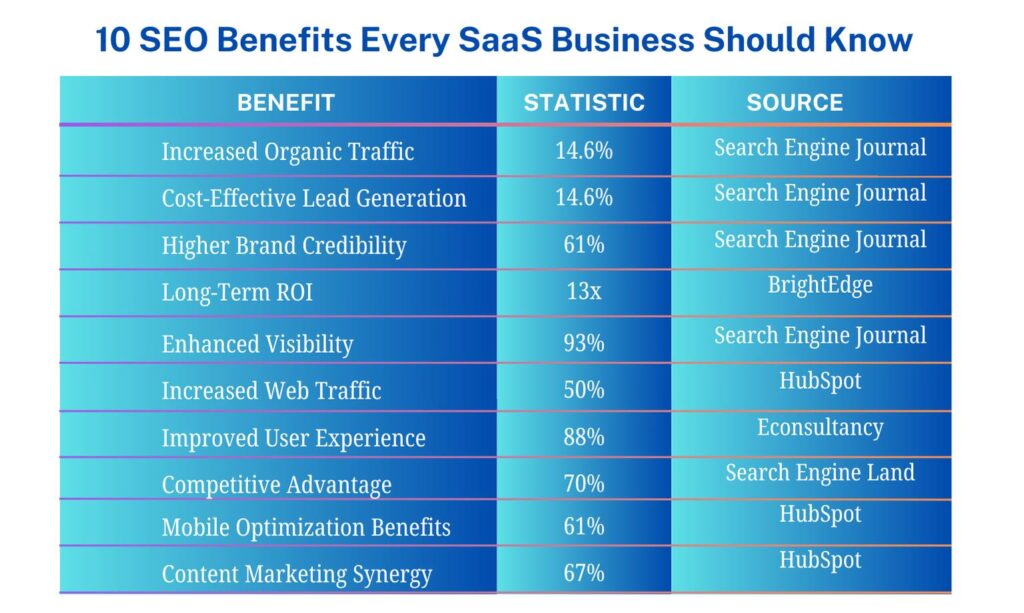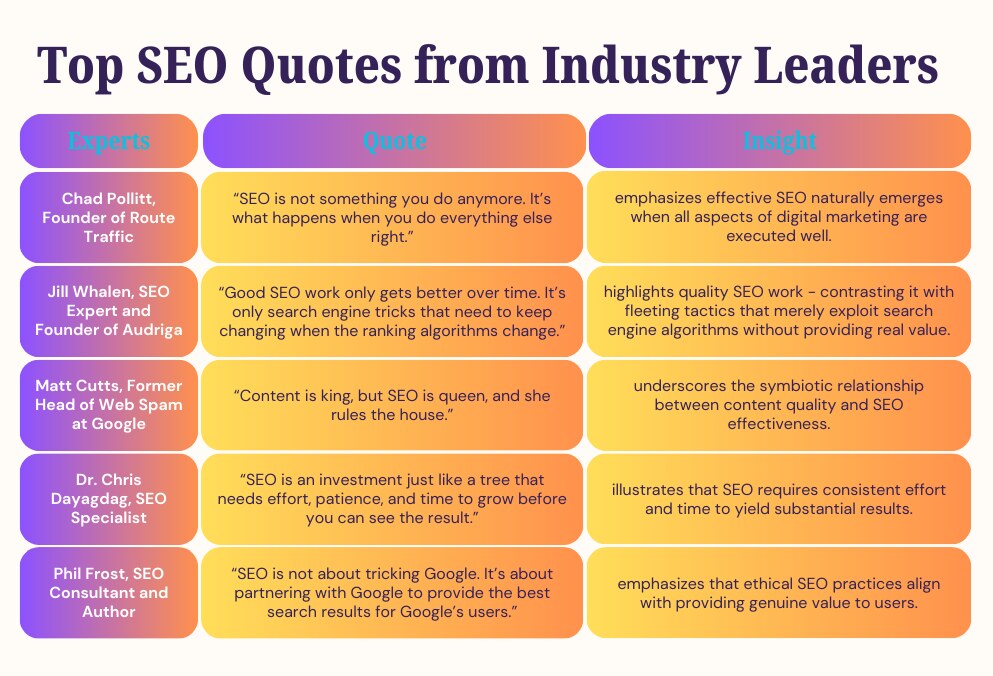SEO Strategy for SaaS in 2025
Are you a small SaaS (Software as a Service) business owner trying to navigate the challenges of online visibility?
If so, you’re not alone.
SEO (Search Engine Optimization) might feel like just another term in a sea of marketing jargon, but it’s so much more than that.
For many small SaaS companies, getting found by the right audience can make or break growth opportunities. So, a well-executed SEO strategy for SaaS is the key to unlocking your business’s true potential online.
Think about it: what good is an incredible service if no one knows it exists?
A strong SEO strategy for SaaS ensures your business stands out, reaches the right people, and fosters genuine connections that lead to conversions.
In this blog, we will guide you through the SEO strategies for SaaS that will be vital in 2025, building on the trends observed in 2023 and 2024. We’ll share practical approaches that can help you drive more traffic, boost brand recognition, and, most importantly, generate leads that ensure sustained growth and success in 2025.
SEO Strategy for SaaS in 2025: Table of Contents
SEO Strategy for SaaS: Key Statistics (2023 & 2024)
An SEO strategy for SaaS, when used thoughtfully, pays off in both the medium and long term.
And, to better understand how SEO can propel your SaaS business forward, let’s look at some key statistics that highlight current industry practices and missed opportunities.
- Nearly 90% of SaaS companies maintain a blog, according to SaaSPartners.io. This underscores the importance of content as part of an SEO strategy.
- Only 36% of these companies use their blogs to provide valuable educational content, as noted by DevSquad. This gap represents a significant opportunity for businesses willing to prioritize high-quality, informative content.
- SaaS businesses investing in content marketing see a growth rate 30% higher than their peers, reports ProfitWell. This shows the tangible impact of aligning SEO with content efforts.
- A well-executed SEO and content marketing strategy can reduce customer acquisition costs by over 87%, according to PoweredbySearch. Lower acquisition costs mean more efficient scaling and sustainable growth.
An optimized website is the foundation, but consistent content development and strategic marketing amplify your SEO strategy for SaaS. Think of it as building a beautiful summer house—it’s only valuable if people can find it.

SEO Strategy for SaaS: Transform Your SaaS Business in 2025
In a market where many SaaS products offer similar solutions and target the same audience, competition is fierce.
The real challenge is determining who will rise above the rest.
The answer lies in crafting an effective SEO strategy for SaaS.
A comprehensive SEO strategy doesn’t just elevate your search engine rankings—it enriches the customer experience, enhances brand awareness, and solidifies your position as an industry leader, driving the conversions your business needs. For SaaS companies, adopting the latest SEO strategy isn’t just a smart move; it’s essential for staying ahead of the competition.
Let’s delve into the most impactful SEO strategies for SaaS that will help you draw more organic leads and set your business up for success in 2025.
1. Understand User Intent with AI-Powered Tools
Search engines powered by advanced AI algorithms prioritize understanding user intent over simple keyword matching. For SaaS companies, this means shifting focus from merely targeting keywords to truly understanding the underlying intent of your audience to strengthen your SEO strategy for SaaS.
Leverage AI-Driven Keyword Research Tools: Utilize tools like Clearscope and Semrush’s AI-powered features to identify intent-driven keywords that align with what users are searching for. Instead of just focusing on traditional keywords, think from the user’s perspective. What problems are they trying to solve? Your SEO strategy for SaaS should reflect the intent behind their searches.
Optimize Content for User Intent: Structure your content to directly address the questions and needs of your audience. Use headers, bullet points, and rich snippets to deliver clear, concise answers that meet user intent effectively. Ensuring your content aligns with user intent will not only improve user experience but also boost your search engine rankings as part of your overall SEO strategy for SaaS.
2. Content Clusters and Pillar Pages
Have you heard about the concept of content clusters? This strategy, which revolves around a central pillar page, became increasingly vital for SaaS SEO in 2024. It involves creating a comprehensive pillar page on a broad topic, supported by cluster pages that delve into specific subtopics to enhance your SEO strategy for SaaS.
Develop Comprehensive Pillar Pages: Begin by crafting in-depth guides or landing pages on core topics relevant to your SaaS offering. These pillar pages should act as the main resource, providing valuable and extensive information to your audience and strengthening your SEO strategy for SaaS.
Link Cluster Content Strategically: Ensure that each supporting article or blog post (cluster content) links back to the pillar page and related content. This strategic interlinking helps search engines recognize the relationship between pages, boosting your site’s authority on the topic and improving your rankings as part of your SEO strategy for SaaS.
3. Leveraging Video Content for SEO
Video content continues to be a powerful tool in 2024 (ever more in 2025), with search engines increasingly favoring pages that feature rich media like videos. According to UserGuiding, posts with videos gain significantly more backlinks and experience a 157% increase in search traffic. However, HubSpot reports that only 31% of marketers are currently using video content to improve SEO. This presents a valuable opportunity for your SaaS company to capitalize on this trend and boost your SEO strategy for SaaS.
Create Explainer Videos: Develop videos that clearly explain your software’s features, benefits, and use cases. Embedding these videos on relevant landing pages and blog posts can boost user engagement and reduce bounce rates, both of which are positive signals for your SEO strategy for SaaS.
Optimize Videos for Search: Ensure your videos are optimized with relevant keywords in the title, description, and tags. Consider hosting your videos on YouTube, the world’s second-largest search engine, to drive additional traffic back to your site and further improve your SEO strategy for SaaS.
4. Technical SEO: Enhancing Site Performance
While many businesses, including those in SaaS, often focus heavily on Off-Page and On-Page SEO, Google’s ongoing emphasis on user experience will make Technical SEO a critical factor in 2025. To rank well, your SaaS company’s website must be fast, secure, and mobile-friendly—just as you promise reliability and quality to your customers. Ensuring Technical SEO is robust is key to a successful SEO strategy for SaaS.
Improve Site Speed: Regularly monitor and optimize your site’s loading time. A slow website not only frustrates users but also leads to higher bounce rates, negatively impacting your SEO strategy for SaaS.
Ensure Mobile Optimization: With 63% of Google searches now originating from mobile devices (Oberlo), it’s essential that your site is fully responsive. Regularly test your site’s mobile performance to ensure a seamless user experience and enhance your SEO strategy for SaaS.
Secure Your Site with HTTPS: Security is a top priority for search engines. Make sure your site is HTTPS-encrypted to protect user data and enhance your search rankings. Just as you guarantee quality and security in your software, your website must reflect the same level of protection, reinforcing your SEO strategy for SaaS.
5. The Power of User-Generated Content
User-generated content (UGC) is one of the most valuable assets for SaaS companies, yet it’s often overlooked in the pursuit of sales. UGC not only enhances credibility but also provides fresh, relevant content that can significantly improve your SEO strategy for SaaS.
Encourage Customer Reviews and Testimonials: Actively feature customer reviews on your website and encourage users to leave feedback on third-party review sites like G2, Capterra, and others. Positive reviews not only build trust but can also help your SaaS product rank higher in search results as part of your SEO strategy for SaaS.
Leverage Forums and Communities: Engage with online communities and forums that are relevant to your SaaS product. Encourage satisfied customers to share their experiences within these spaces, as their testimonials can generate valuable backlinks and drive traffic to your site, bolstering your SEO strategy for SaaS.
6. Optimizing for Voice Search
Voice search will continue to gain popularity in 2025. Optimizing your content for voice queries is no longer optional—it’s essential for your SEO strategy for SaaS. Just as your product evolves, so should your website, ensuring it’s fully optimized for voice search.
Focus on Conversational Keywords: Incorporate conversational, long-tail keywords and question phrases into your website and blog content. While it might seem unusual to use keywords that are up to 10 words long, they are crucial for capturing voice search traffic as part of your SEO strategy for SaaS.
Provide Clear and Concise Answers: Optimize your content to directly answer common questions. Implement FAQ sections and use structured data markup to enhance your chances of appearing in voice search results, making your site a go-to source for quick, accurate information and strengthening your overall SEO strategy for SaaS.
7. Implementing AI for Predictive SEO
How are you integrating AI into your SEO strategy for SaaS? AI is revolutionizing SEO by enabling predictive analysis, allowing you to anticipate trends, user behavior, and search engine changes before they happen.
Utilize Predictive Analytics Tools: Leverage tools like BrightEdge and MarketMuse to forecast which content will perform well based on emerging trends. This proactive approach lets you optimize your SEO strategy for SaaS in advance, keeping you ahead of the competition.
Create Content That Anticipates User Intent: Use AI to analyze past user behavior and predict future search patterns. By creating content that addresses upcoming trends and recurring pain points, you can ensure your SaaS company remains relevant and visible in search results as part of your comprehensive SEO strategy for SaaS.
8. Building High-Quality Backlinks
Despite evolving SEO trends, backlinks will remain a powerful ranking factor even in 2025. According to UserGuiding, backlinks are still among the top three ranking factors. However, over 65% of web pages lack any backlinks, presenting a significant opportunity for your SaaS company’s SEO strategy for SaaS to stand out. The same report also highlights that long-form content garners 77% more backlinks, and posts with videos see a 157% increase in search traffic.
Guest Blogging: Contribute high-quality content to reputable industry blogs and websites. This not only helps you earn valuable backlinks but also strengthens your brand’s authority within your niche, supporting your SEO strategy for SaaS.
Collaborate with Influencers: Partner with influencers in your industry to co-create content or host webinars. Influencers often have high-domain authority, and backlinks from their platforms can significantly enhance your SEO strategy for SaaS.
9. Enhancing the User Experience (UX)
While you may be intimately familiar with your website, remember that most customers are visiting it for the first time. For SaaS companies, this means ensuring that users can easily navigate your site and find what they need. Also, search engines are increasingly rewarding websites that offer an exceptional user experience, which is a crucial aspect of your SEO strategy for SaaS.
Streamline Navigation: Simplify your website’s navigation to make it as intuitive as possible. A well-organized site structure not only improves user experience but also enhances crawlability, helping search engines index your pages more effectively, boosting your SEO strategy for SaaS.
Focus on Content Readability: Use clear and concise language, and break up your content with headers, images, and bullet points. Readable content keeps users engaged and helps search engines better understand and rank your content, supporting your overall SEO strategy for SaaS.
10. Regularly Update and Repurpose Content
SEO is not a one-time effort—it requires consistent attention and action. Regularly updating, optimizing, and repurposing your content is essential to maintaining or improving your rankings over time as part of your SEO strategy for SaaS.
Refresh Outdated Content: Periodically review older content to ensure it remains current and valuable. Updating statistics, incorporating new insights, and enhancing content quality can revitalize underperforming pages and keep them relevant in search results, strengthening your SEO strategy for SaaS.
Repurpose High-Performing Content: Identify your best-performing content and repurpose it into various formats, such as infographics, videos, or podcasts. This not only extends the life and reach of your content but also helps keep your audience engaged with fresh and relevant material, further enhancing your SEO strategy for SaaS.

Conclusion: SEO Strategy for SaaS and Way Forward
In 2025, mastering a robust SEO strategy for SaaS will be essential for driving quality leads and increasing traffic to your site.
SaaS SEO demands more than just occasional attention—it requires continuous effort, strategic focus, and adaptability. Even in a competitive market, smaller SaaS companies can thrive by implementing the right tactics, despite the challenges posed by well-funded competitors. By effectively applying these 10 strategies outlined, your SaaS business can achieve sustained growth and exceed expectations.
Moreover, today’s SEO strategy for SaaS extends far beyond simple keyword optimization. It’s about understanding user intent, leveraging AI-driven tools, creating authoritative content clusters, and delivering an exceptional user experience. These strategies help build trust, foster user engagement, and position your company as an industry leader.
Investing in video content, enhancing technical SEO, and focusing on user-generated content are powerful methods to differentiate your SaaS brand. Don’t forget the importance of building high-quality backlinks and optimizing for emerging trends like voice search—these efforts will contribute to long-term success.
As the digital landscape continues to evolve, refining and updating your SEO strategy for SaaS is crucial to staying relevant and visible. By staying proactive, embracing AI technologies, and regularly repurposing and refreshing your content, your SaaS company can maintain a competitive edge and secure lasting growth in an ever-changing market. Prioritize these elements, and your SaaS SEO strategy will not just meet but surpass your business goals.

